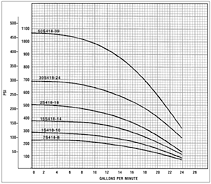
Selecting a pump is a three-step process. First, determine the pumping requirements of the job as we did in the last few articles. Second, decide which brand and type of pump (jet or submersible) to use. Then, go to the catalogs and select a pump.
Which brand - There are many very good pumps out there. In truth, you really cannot go too far wrong with any of them. Some will handle sand better than others, but most will perform up to their curves and provide reliable service for a number of years.
Jet or submersible pump - As a rule of thumb, if most of the pumps in your area are jet pumps, install a jet. If most of them are subs, go with a sub. If there isn't a clear-cut pump of choice in the area, consider several other factors:
1. Jet pumps are located aboveground, which makes them easy to service -- so easy in fact that many home owners will do their own service work. Not good for a service-oriented pump company.
2. In terms of pump purchase price, when you consider that a 1⁄2-HP sub performs about the same as a 1-HP jet, the pumps cost about the same. However, when the cost of the pump cable is thrown in with a sub, the cable is longer and possibly larger since it runs down the well to the pump -- the jet could be cheaper.
3. Jets usually are the pumps of choice when the pumping level is 25 feet or less. Jets can work down to 200 feet, but since 50 percent or more of their power goes into re-circulating the water through the jet nozzle to provide the lift, they are not as efficient as subs, so it will cost the homeowner more money in electricity to pump with a jet. The deeper the well, the more the balance swings over to subs.
Personally, I would go with a sub if the pumping level is deeper than 25 feet. If you know that some of your competition is bidding a jet, but you want to bid a sub, offer a jet as an alternative and sell your customer up to the sub for its added efficiency.
Performance curves versus performance charts - Most pump manufacturers present their performance information for submersible pumps in the form of performance curves and performance charts. We will look at performance curves this month and get into performance charts next month.

The six pumps on this curve all use the same impeller and diffuser assemblies but differ in the number of stages (impeller/diffuser sets) and the horsepower it takes to drive them. The more stages, the more pressure the pump will provide. The first number of the model number represents the horsepower, and the last number is the number of stages. To use a curve like this, select the pump that has a curve above the operating point needed for your application.
The operating point is the point on the curve where the gpm required for the application meets the pressure required. Last month, we finished our series on pressure drop with a hypothetical application requiring 20 gpm at 229.5 feet of head. To find this operating point on Figure 1, draw a line up from 20 gpm and over from 229.5 feet of head. Where the two lines intersect is the operating point for this application. As you see, this operating point is just above the 11⁄2-HP pump curve.
Any pump at or above the operating point will do the job, so you normally would use the 2-HP pump. Don?t be tempted to choose the 11⁄2-HP pump unless your operating point calculations were very conservative. At the design pressure of 229.5 feet of head, your pump only would give you a little more than 18 gpm. Or, at 20 gpm, you would have only 200 feet of pressure to work with. Remember, over the years, the pump's performance may begin to fall off, and, as we have said before, it is always better to give your customers more than they expected. Don't go overboard, though. The 3 HP and 5 HP pumps would work but would be overkill for this application.
Next month, we will continue with Part 2 and a look at how pump curves are generated and how to use some of the other information often found on pump curves. 'Til then ... .

Report Abusive Comment